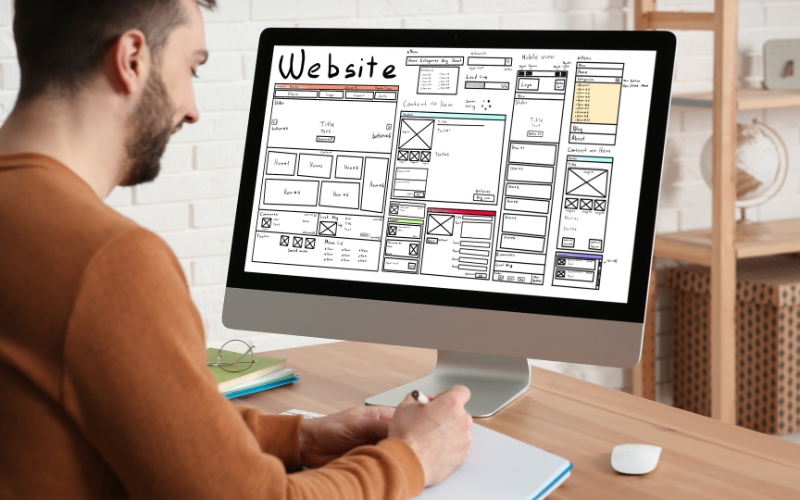
In today’s competitive online landscape, optimizing website design is essential for driving user engagement and maximizing conversions. One of the most effective ways to achieve this is through website heatmaps optimization, a strategy that provides valuable insights into user behavior. By visually representing clicks, scrolls, and mouse movements, heatmaps reveal how visitors interact with different elements of a website. This data empowers designers and marketers to make informed decisions that enhance user experience and optimize website performance.
Understanding Website Heatmaps: A Key Tool for Design Insights

Website heatmaps optimization is a powerful strategy that enables designers and marketers to visually understand user interaction on their websites. By tracking clicks, scrolls, and mouse movements, heatmaps provide an intuitive representation of how visitors engage with different elements of a webpage. These visual data insights are crucial for making informed decisions about website design, improving user experience (UX), and optimizing conversion rates.
A heatmap is essentially a graphical representation where different colors correspond to the intensity of user activity. For instance, areas with frequent clicks or mouse movement are highlighted in warm colors like red or orange, while less active areas are shown in cooler tones like blue or green. This provides a clear and immediate understanding of which sections of a webpage attract the most attention and which areas are neglected. With this information, businesses can tailor their design choices to improve engagement and performance.
One of the primary advantages of website heatmaps optimization is that it allows website owners to track and visualize user behavior without relying solely on analytics data, which can be complex and hard to interpret. Heatmaps strip away the complexity by offering an easy-to-understand visual format that presents where users focus most of their attention. Whether it’s a product image, a call-to-action button, or a piece of content, heatmaps can show exactly where users click, how far they scroll, and where they hover their mouse, allowing you to optimize these areas for greater impact.
This optimization tool helps identify user frustrations as well. For example, heatmaps can reveal if visitors are clicking on non-interactive elements, indicating that they may be confused by the layout. Similarly, they can show areas where users tend to abandon the page, allowing designers to pinpoint potential issues with user flow or content engagement.
By incorporating website heatmaps optimization into the design process, businesses can make data-driven decisions that not only enhance the website’s visual appeal but also improve usability and functionality. The insights gained from heatmaps help create a user-friendly experience by focusing on the areas that matter most to the audience, ultimately leading to higher engagement and conversions.
How Heatmaps Inform User Experience (UX) and Design Choices

Website heatmaps optimization plays a crucial role in shaping user experience (UX) and guiding design decisions. By visually presenting user interactions, heatmaps offer a wealth of data that designers can leverage to improve website layouts, content placement, and overall user flow. Understanding how users engage with a website allows designers to make informed, data-backed decisions that directly impact the effectiveness and usability of a site.
Heatmaps capture various forms of user behavior, including clicks, scrolls, and mouse movements. These insights reveal areas where users interact the most, such as specific links, buttons, or images. By analyzing this data, designers can identify which elements of the page are engaging users and which ones are being overlooked. This information is vital for website heatmaps optimization because it highlights where adjustments need to be made to improve user interaction.
For instance, if a call-to-action (CTA) button is not receiving enough clicks, it may be buried too far down the page or placed in an ineffective location. Heatmaps can reveal such issues, prompting designers to reposition the CTA for better visibility. Similarly, heatmaps can uncover whether important content is being missed by users. If users are skipping over vital information, the layout might need to be adjusted to ensure that the most important sections are given more prominence.
Another significant way website heatmaps optimization informs UX design is by revealing how users navigate through a page. By analyzing scroll heatmaps, designers can understand how far down the page users typically go, indicating whether the content is too long or if critical information is being missed. This insight allows designers to streamline user journeys by ensuring that essential content appears above the fold or in easily accessible areas.
Moreover, heatmaps can also help designers understand user frustration points. For example, if users repeatedly click on a non-interactive element, it may indicate confusion or a poor design choice. Heatmaps can also pinpoint areas where users abandon a page or fail to convert, providing valuable feedback for improving the overall user experience.
Incorporating website heatmaps optimization into the UX design process ultimately results in a more intuitive and engaging website. By aligning design decisions with actual user behavior, designers can enhance website functionality, improve usability, and ensure a smoother user journey that drives higher engagement and conversions.
Types of Heatmaps: Click, Scroll, and Move – Which One to Use?

Website heatmaps optimization involves various types of heatmaps, each providing distinct insights into user behavior. The three main types—click heatmaps, scroll heatmaps, and mouse movement heatmaps—offer valuable data that can be leveraged to improve website design and user experience. Understanding the differences between these heatmaps and knowing when to use each one is key to making the most of website heatmaps optimization.
1. Click Heatmaps
Click heatmaps are one of the most common and valuable tools for website heatmaps optimization. They show exactly where users click on a webpage, highlighting the most and least clicked areas. By analyzing click heatmaps, designers can identify which elements of a page—such as buttons, images, or links—are receiving the most attention. This information is vital for optimizing call-to-action (CTA) buttons, ensuring they are placed in highly interactive areas where users are most likely to engage. Additionally, click heatmaps can reveal any areas where users are mistakenly clicking on non-interactive elements, such as images or text, suggesting potential layout improvements.
2. Scroll Heatmaps
Scroll heatmaps are another essential tool in website heatmaps optimization, helping designers understand how far users scroll down a page. This type of heatmap reveals how far visitors typically go before they stop scrolling, providing insights into how engaging the content is throughout the page. If users tend to stop scrolling early, it may indicate that the content isn’t captivating enough or that important information is placed too far down the page. Scroll heatmaps are especially useful for long-form content or landing pages. Designers can optimize content placement, ensuring that critical information, such as key CTAs, is visible above the fold to maximize engagement.
3. Mouse Movement Heatmaps
Mouse movement heatmaps track the path of users’ mouse cursors as they navigate through a webpage. Although they do not show clicks or scroll depth, they provide valuable insights into how users interact with the layout and content. Since users’ mouse movements often mimic their focus on the page, mouse movement heatmaps can help identify which areas of a page attract the most attention, even if those areas aren’t clicked. This is particularly useful for understanding engagement with visual elements, like images or promotional banners, that may not necessarily be interactive but still play an important role in the user experience.
Which One to Use?
The type of heatmap to use largely depends on your design goals. For evaluating user engagement with interactive elements, click heatmaps are the go-to tool. If your goal is to understand content consumption and identify where users drop off on long pages, scroll heatmaps are essential. Finally, if you’re looking to assess visual engagement and user behavior with non-clickable elements, mouse movement heatmaps provide unique insights. Integrating these heatmaps in website heatmaps optimization can ensure that every aspect of your website design is optimized for maximum user interaction and engagement.
Optimizing Website Layouts Based on Heatmap Data

Website heatmaps optimization offers valuable insights that can directly impact the layout and structure of a website. By analyzing data from heatmaps—such as click, scroll, and mouse movement heatmaps—designers and marketers can make informed decisions to enhance content placement, call-to-action (CTA) visibility, and overall site navigation. The data gathered from heatmaps helps identify which areas of a webpage attract the most attention and which are ignored, providing a clear path to optimizing the layout for improved user engagement and higher conversion rates.
Improving Content Positioning
One of the key benefits of website heatmaps optimization is the ability to refine content positioning. Heatmaps reveal which sections of a page are receiving the most attention from users and which sections are being overlooked. If certain content is consistently ignored or overlooked by users, it may be due to its placement on the page. For instance, important information might be placed too far down or hidden in areas that users typically don’t engage with. By repositioning this content to more prominent locations—such as above the fold or near highly interactive areas—designers can increase the likelihood that users will engage with the content, thus improving the effectiveness of the website.
Optimizing Call-to-Action Buttons
CTA buttons are a critical element of any website, as they directly influence conversion rates. Heatmaps provide essential data that can be used for website heatmaps optimization by showing whether users are engaging with CTA buttons or ignoring them. For example, if users are not clicking on a CTA button placed at the bottom of a page, it may indicate that the button is not easily noticeable or placed too far down. By analyzing click heatmaps, designers can identify where users are most likely to click and reposition CTAs accordingly. Additionally, ensuring that CTA buttons are visually prominent, using contrasting colors or larger sizes, can also improve engagement based on heatmap insights.
Enhancing Navigation
Navigation plays a critical role in the user experience of any website. Heatmaps can help identify where users tend to hover, click, or spend time while navigating a site. If users are frequently clicking on non-interactive elements or struggling to find their desired information, it may indicate issues with the navigation structure. Website heatmaps optimization allows designers to refine the navigation by making it more intuitive, such as ensuring that important links and menus are placed in areas where users are most likely to engage. Simplifying navigation by reducing unnecessary steps or reorganizing the menu based on heatmap data can also enhance user experience and lead to better engagement.
Incorporating website heatmaps optimization into the design process provides a data-driven approach to layout improvements, which ultimately boosts user interaction and conversion rates. By continuously analyzing heatmap data and refining the layout based on user behavior, businesses can create websites that are more user-friendly and conversion-optimized.
Combining Heatmaps with A/B Testing for Continuous Website Improvement

Website heatmaps optimization, when combined with A/B testing, offers a powerful, data-driven approach to continuously improving website designs. While heatmaps provide visual insights into user behavior—such as where users click, scroll, or hover—A/B testing allows businesses to experiment with different versions of web pages to see which design elements perform best. When used together, these tools can help refine a website’s layout, content, and overall user experience, leading to higher engagement and conversions.
How Heatmaps and A/B Testing Complement Each Other
Heatmaps reveal detailed insights into how users interact with a website, helping to identify which areas capture their attention and which are ignored. This data can highlight potential areas for improvement, such as poorly placed call-to-action (CTA) buttons, text-heavy sections, or ineffective content layout. However, heatmaps alone may not provide the full context needed to determine the most effective design changes. This is where A/B testing comes in.
A/B testing allows you to test two or more variations of a webpage to compare their performance. For example, you can test two different CTA button placements or different headlines to determine which version performs better in terms of user engagement or conversion rates. By integrating website heatmaps optimization into A/B testing, you can see not only which version of the page performs best but also how users interact with the design changes. Heatmaps can help visualize why one version is outperforming another by showing where users click, how far they scroll, and what areas they focus on most.
Data-Driven Insights for Continuous Improvement
Combining heatmaps with A/B testing enables a continuous feedback loop that fuels ongoing website optimization. After conducting an A/B test and analyzing the results, heatmaps provide further context, offering clear visual insights into user behavior that explain why one version of a page might be more successful. For example, if a new layout leads to higher engagement with a CTA button, heatmaps can confirm whether the increased clicks are due to the button’s placement, size, or color.
This data-driven approach ensures that every design change is backed by user behavior insights, leading to a website that continually evolves based on what users actually want. Moreover, the ability to test and optimize pages based on both heatmap data and A/B testing results ensures that a website remains user-centric and effective at meeting its business goals.
Conclusion
To take your website optimization even further, it’s crucial to stay updated with the latest tools and techniques. For example, you can explore Hotjar, a leading platform that offers heatmap, session recording, and other user feedback tools to enhance your website design and usability. Leveraging such tools can help you visualize how users interact with your website, enabling more effective design adjustments that can lead to improved user engagement and conversion rates.
Incorporating website heatmaps optimization into your design process is key to creating a user-friendly website that aligns with user preferences and maximizes engagement. By understanding how users interact with different elements, businesses can refine their design, improve content placement, and ensure that key actions, such as clicks on call-to-action buttons, are effectively captured. Combining heatmaps with other optimization tools, like A/B testing, creates a robust framework for continuous improvement, leading to a more intuitive, conversion-optimized website that meets both business and user needs.
For more details or to discuss your specific Website Development and Design, visit our Website Development and Design page.

